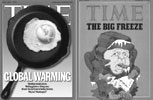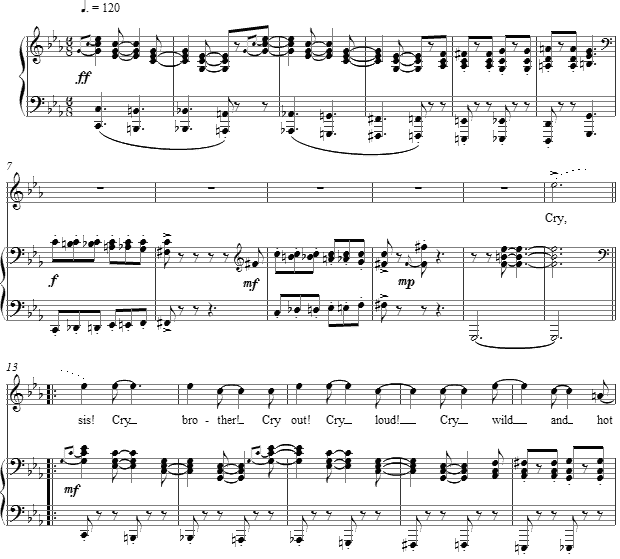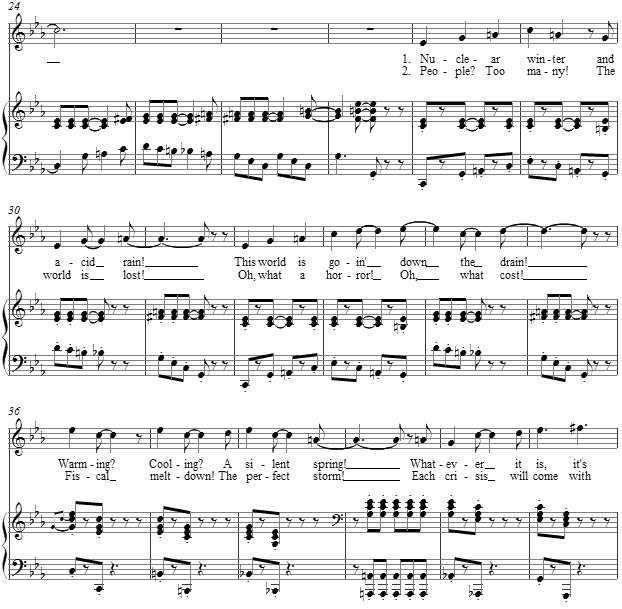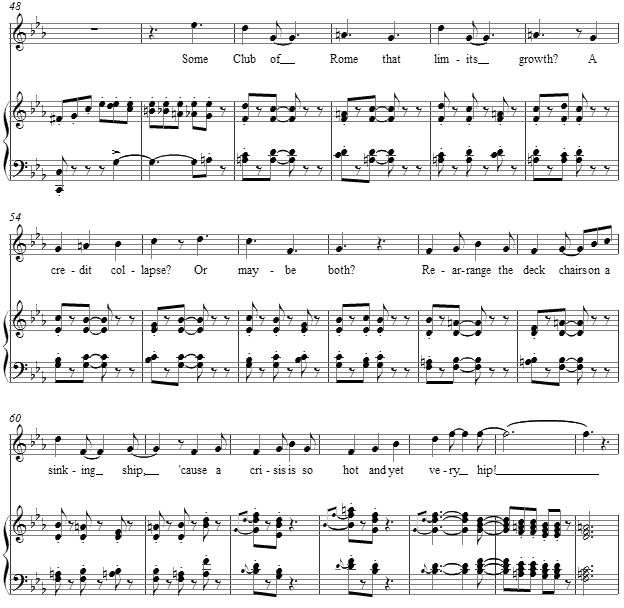Music and Texts of GARY BACHLUND
Vocal Music | Piano | Organ | Chamber Music | Orchestral | Articles and Commentary | Poems and Stories | Miscellany | FAQs
Crisis - (2009)
Gary Bachlund
for medium or high voice and piano
Cry, sis! Cry, brother!
Cry out! Cry loud!
Cry wild and hot
With the crying crowd!
Crisis!
Nuclear winter and acid rain?
This world? It's goin' down the drain!
Warming? Cooling? A silent spring!
Whatever it is, it's threatening!
Cry, sis! Cry, brother!
Cry out! Cry loud!
Cry wild and hot
With the crying crowd!
People? Too many! The world's lost!
Oh, what horror! Oh, what cost!
Fiscal meltdown! The perfect storm!
Each crisis will come with frightening form!
Some Club of Rome that limits growth?
A credit collapse? Or maybe both!
Rearrange the deck chairs on a sinking ship,
'Cause a crisis is so hot and yet very hip!
Crisis!
Cry, sis! Cry, brother!
Cry out! Out loud!
Cry wild and hot
With the crying crowd!
Crashes are coming! The end time nears!
One of these things should stir your fears!
Grab your crying towel and weep!
Apocalypse comes! Come shed those tears!
Cry, sis! Cry, brother!
Cry out! Out loud!
Cry wild and hot
With the crying crowd!Copyright © 2009 by Gary Bachlund All international rights reserved.
[ 5 pages, circa 2' 35" ]
Global Warming AND The Big Freeze
The news of late has featured exposés on hacked email, complete with seemingly bogus computer modeling code, fudge factors, cherry picking of data and other equally impressive scientific methods at work in service to the latest orthodoxy of the moment -- climate change, only recently known as global warming. Thirty and more years ago when I was a young student, my issues of Scientific American were replete with similar computer modeling predicting global cooling, and suggestions on how to control the climate. I recall from my school days arguing for the coming ice age, quite with the passion of foolish youthful ardor, for when one is young, one is always correct even when incorrect.
The above graphics placing an American news magazine's two absolutely opposing cover stories, spanning decades, illustrates the point rather well. The issue comes down to one of government expenditures versus freedom from coercive taxation, for in both the cooling hysteria and today's warming "climate" the discussion reverts -- as it seems to always do -- to money, and little more. Who pays? Who receives? Who administers? Who wins? Who loses? As clever observers note, "business is merely warfare by other means," and this warfare seems between the business of governance, on the one hand, and nations filled with individuals struggling to make a living and enjoy life in spite of the burdens laid upon them through various policy and taxation regimes.
As ever, the apocalyptic vision fills the storytellers' pages. This was ever so, for the world's major religions have predicted a form of worldwide catastrophe for centuries. This includes the modern religion evidencing its own "belief" system -- for computer models to foretell the massive changes of weather across decades are a matter a matter of belief, as much as of ostensible science. And on both sides of the political debate, a viewpoint is bolstered more by belief than hard data -- and I argue this especially based on the "lost" data of some recent computer modelers who were careful to safeguard their conclusions, but foolish and flippant about preserving the original data for the one procedure which could validate any effort by science at large -- and independent verification.
This pop-style, up tempo setting opens with its signature syncopation, the tonic minor over and against a bass line descending by half steps. The half cadence results in that traditional diabolus in musica, the tritone, for it is always true that "the devil is in the details." The vocal line opens with the lyrics' refrain which then moves directly to a verse, wholly related to the refrain.
The three verses linked to the refrain jostle back and forth between the written duple and triple feeling as the hemiola conflicts with the underlying accompaniment. The later half of these verses halves the harmonic rhythm of the refrain coming to the highest tessitura of the setting. The tessitura lies intentionally a little higher than other settings to heighten the intensity with which such various and varying "end time" visions dance across the setting.
The formal bridge takes what was planned as another verse, by measure of the scansion and rhyme form, and breaks for a relief from the hard driving minor tonic. From a major six subdominant, the bridge slips to the mediant and pushes the harmonic region into a cadence on B flat, which then yields again to the musical "terrors" of the tonic minor.
The score for Crisis is available as a free PDF download, though any major commercial performance or recording of the work is prohibited without prior arrangement with the composer. Click on the graphic below for this piano-vocal score.



